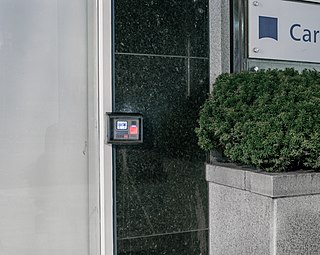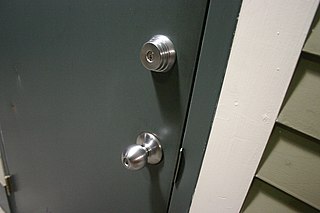This article needs additional citations for verification .(January 2017) |

An exit control lock, also known as an exit control device, exit lock, or simply an exit control, prevents or deters unauthorized exit. [1]
This article needs additional citations for verification .(January 2017) |

An exit control lock, also known as an exit control device, exit lock, or simply an exit control, prevents or deters unauthorized exit. [1]
Exit control locks are often used in retail establishments to deter shoplifting. They are also used in airports and other controlled areas, where people are held until they clear customs or quarantine stations. Exit control locks are also used in libraries, where there is one well-staffed entrance and exit, and a number of other exits that are intended for emergency use only. Exit control devices are often used in hospitals, and can be interfaced to wireless sensors worn by newborn children, so that all exits will lock if a baby is stolen from one of the hospital rooms.
Often, shops will make an exit emergency use only to deter shoplifting. Usually, the door is locked with an emergency exit button next to it. Pushing the emergency exit button will unlock the door and set the shop's fire alarm off. This deters shoplifting because a person who unlocks the door in order to take an item out of the building when it is not an emergency may be reported to the police, with CCTV footage if available.
Many exit control locks are based on magnetic locks. One type, delayed egress magnetic locks, will not allow the door to open immediately. This allows a guard to get to the door before the door opens. It will also release if there is a fire alarm or power failure, but otherwise these locks hold the exit doors shut. These units are common in Alzheimer units.
Exit control systems can include a "request to exit detector" such as a pushbutton that opens the exit if exit requests are enabled.
In other facilities, entrances as well as exits require authentication such as swiping or otherwise reading a card with a card reader. If an intruder slips by the entrance controls of a building, they will be able to be detained for questioning.

In the fields of physical security and information security, access control (AC) is the selective restriction of access to a place or other resource, while access management describes the process. The act of accessing may mean consuming, entering, or using. Permission to access a resource is called authorization.

Physical security describes security measures that are designed to deny unauthorized access to facilities, equipment and resources and to protect personnel and property from damage or harm. Physical security involves the use of multiple layers of interdependent systems that can include CCTV surveillance, security guards, protective barriers, locks, access control, perimeter intrusion detection, deterrent systems, fire protection, and other systems designed to protect persons and property.

Shoplifting is the theft of goods from an open retail establishment, typically by concealing a store item on one's person, in pockets, under clothes or in a bag, and leaving the store without paying. With clothing, shoplifters may put on items from the store and leave the store wearing the clothes. The terms shoplifting and shoplifter are not usually defined in law. The crime of shoplifting generally falls under the legal classification of larceny. Shoplifting is distinct from burglary, robbery, or armed robbery. In the retail industry, the word shrinkage can be used to refer to merchandise lost by shoplifting, but the word also includes loss by other means, such as waste, uninsured damage to products and theft by store employees.

A lock is a mechanical or electronic fastening device that is released by a physical object, by supplying secret information, by a combination thereof, or it may only be able to be opened from one side, such as a door chain.
A child safety lock is a special-purpose lock for cabinets, drawers, bottles, etc. that is designed to help prevent children from getting at any dangerous things or contents. Young children are naturally curious about their surroundings and will always explore, but as they may be unaware of dangerous substances or situations, the results can be fatal. Numerous cases of poisoning have resulted from eating brightly colored pills or spilling cleaning solvents.

On trains, the expression emergency brake has several meanings:

A dead bolt, deadbolt or dead lock is a locking mechanism distinct from a spring bolt lock because a deadbolt can only be opened by a key or handle. The more common spring bolt lock uses a spring to hold the bolt in place, allowing retraction by applying force to the bolt itself. A deadbolt can therefore make a door more resistant to entry without the correct key, as well as make the door more resistant to forced entry. A deadbolt is often used to complement a spring-bolt lock on an entry door to a building.

A crash bar is a type of door opening mechanism which allows users to open a door by pushing a bar. While originally conceived as a way to prevent crowd crushing in an emergency, crash bars are now used as the primary door opening mechanism in many commercial buildings.

An emergency exit in a structure is a special exit for emergencies such as a fire: the combined use of regular and special exits allows for faster evacuation, while it also provides an alternative if the route to the regular exit is blocked.

Power door locks allow the driver or front passenger to simultaneously lock or unlock all the doors of an automobile or truck, by pressing a button or flipping a switch.
Electronic article surveillance is a technological method for preventing shoplifting from retail stores, pilferage of books from libraries or removal of properties from office buildings. Special tags are fixed to merchandise; these tags are removed or deactivated by the clerks when the item is properly bought or checked out. At the exits of the store, a detection system sounds an alarm or otherwise alerts the staff when it senses active tags. Some stores also have detection systems at the entrance to the restrooms that sound an alarm if someone tries to take unpaid merchandise with them into the restroom. For high-value goods that are to be manipulated by the patrons, wired alarm clips called spider wrap may be used instead of tags.

A remote keyless system (RKS), also known as keyless entry or remote central locking, is an electronic lock that controls access to a building or vehicle by using an electronic remote control.

A latch or catch is a type of mechanical fastener that joins two objects or surfaces while allowing for their regular separation. A latch typically engages another piece of hardware on the other mounting surface. Depending upon the type and design of the latch, this engaged bit of hardware may be known as a keeper or strike.

An electronic lock is a locking device which operates by means of electric current. Electric locks are sometimes stand-alone with an electronic control assembly mounted directly to the lock. Electric locks may be connected to an access control system, the advantages of which include: key control, where keys can be added and removed without re-keying the lock cylinder; fine access control, where time and place are factors; and transaction logging, where activity is recorded. Electronic locks can also be remotely monitored and controlled, both to lock and to unlock.

An electric strike is an access control device used for door frames. It replaces the fixed strike faceplate often used with a latch. Like a fixed strike plate, it normally presents a ramped or beveled surface to the locking latch allowing the door to close and latch just like a fixed strike would. However, an electric strike's ramped surface can, upon command, pivot out of the way when the lock on the door is in the locked position and the door is opened, allowing a user to pull/push the door to open it without operating the mechanical lock or using a mechanical key. After the door is opened past the keeper, the keeper returns to its standard position and re-locks when power is removed or applied, depending upon the strike's configuration.
A keycard lock is a lock operated by a keycard, a flat, rectangular plastic card. The card typically, but not always, has identical dimensions to that of a credit card or American and EU driver's license. The card stores a physical or digital pattern that the door mechanism accepts before disengaging the lock.

The term door security or door security gate may refer to any of a range of measures used to strengthen doors against door breaching, ram-raiding and lock picking, and prevent crimes such as burglary and home invasions. Door security is used in commercial and government buildings, as well as in residential settings.

An electromagnetic lock, magnetic lock, or maglock is a locking device that consists of an electromagnet and an armature plate. There are two main types of electric locking devices. Locking devices can be either "fail safe" or "fail secure". A fail-secure locking device remains locked when power is lost. Fail-safe locking devices are unlocked when de-energized. Direct pull electromagnetic locks are inherently fail-safe. Typically the electromagnet portion of the lock is attached to the door frame and a mating armature plate is attached to the door. The two components are in contact when the door is closed. When the electromagnet is energized, a current passing through the electromagnet creates a magnetic flux that causes the armature plate to attract to the electromagnet, creating a locking action. Because the mating area of the electromagnet and armature is relatively large, the force created by the magnetic flux is strong enough to keep the door locked even under stress.
A mantrap, security mantrap portal, airlock, sally port or access control vestibule is a physical security access control system comprising a small space with two sets of interlocking doors, such that the first set of doors must close before the second set opens. Airlocks have a very similar design, allowing free ingress and egress while also restricting airflow.

The term window security may refer to any of a range of measures used to avoid unauthorized access through windows, and prevent crimes such as burglary and home invasions. Window security is used in commercial and government buildings, as well as in residential settings.